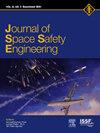国际液镜望远镜偶然发现轨道碎片
IF 1
Q3 ENGINEERING, AEROSPACE
引用次数: 0
摘要
国际液镜望远镜是一个 4 米长的天顶指向光学望远镜,采用旋转液态主镜。它位于印度喜马拉雅山脉,于 2022 年 10 月开始运行。该望远镜配备了一台 CCD 摄像机,视场为 22 x 22 弧分,采用延时积分读出法对地球自转进行补偿。虽然该望远镜的主要用途是使用宽带滤光片进行天文巡天观测,但它对地球轨道上穿过其视场的天体也很敏感,这些天体会留下可探测到的条纹。我们检查了第一年观测期间获得的所有图像,并确定了所有探测到的天体的凌日时间和位置角。我们将这些数据与公开的双线要素(传播到观测时间)进行了比较,以确定已编入目录的天体。在 1838 幅图像中总共发现了 301 条条纹。其中,64%与编目天体相吻合。大部分被识别的天体都在低地球轨道上,高度在 400-1600 公里之间。被识别出的天体在 V 波段的视星等从 3.6 到 15.1 不等。还可以推断出 29%的未识别天体的角速率、视星等和高度。V 波段的视星等从 6.4 到 19.5 不等,估计高度从 285 到 30 多万千米不等。本文章由计算机程序翻译,如有差异,请以英文原文为准。
Serendipitous detection of orbital debris by the International Liquid Mirror Telescope
The International Liquid Mirror Telescope is a 4-m zenith-pointing optical telescope that employs a rotating liquid primary mirror. Located in the Indian Himalayas, it began operations in October 2022. The telescope is equipped with a CCD camera that has a 22 x 22 arcmin field of view and employs time-delay integration readout to compensate for the Earth’s rotation. While its primary purpose is to conduct astronomical survey observations using broad-band filters, the telescope is also sensitive to objects in Earth orbit that pass through its field of view, leaving detectable streaks. We have examined all images obtained during the first year of observations and determined the transit times and position angles of all detected objects. These were compared with publicly available two-line elements, propagated to the time of observation, in order to identify cataloged objects. A total of 301 streaks were found in 1838 images. Of these, 64% were identified with cataloged objects. Most of the identified objects are in low-Earth orbit, in the altitude range of 400–1600 km. The apparent magnitudes of the identified objects range from 3.6 to 15.1 in the V band. It was also possible to infer angular rates, apparent magnitudes and altitudes for 29% of the unidentified objects. The V-band magnitudes range from 6.4 to 19.5 and the estimated altitudes range from 285 to over 300,000 km.
求助全文
通过发布文献求助,成功后即可免费获取论文全文。
去求助
来源期刊

Journal of Space Safety Engineering
Engineering-Safety, Risk, Reliability and Quality
CiteScore
2.50
自引率
0.00%
发文量
80
 求助内容:
求助内容: 应助结果提醒方式:
应助结果提醒方式:


